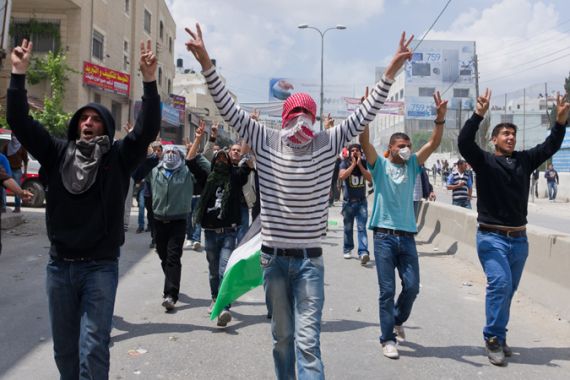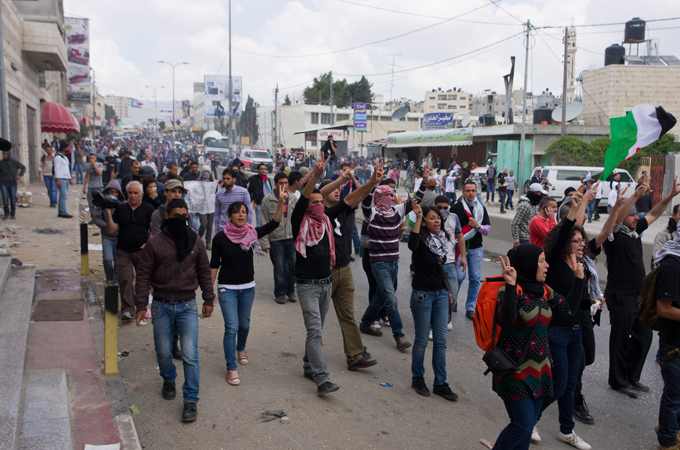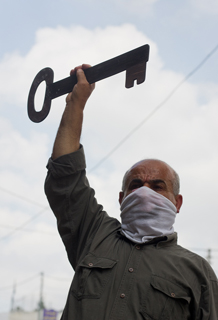Green shoots emerge at Qalandia checkpoint
The Arab Spring has reached Palestine, with a day of mass protests commemorating the 63rd anniversary of the ‘Nakba’.

 |
| Thousands of activists took part in the mass protests planned across the region to commemorate the ‘Nakba’ – the 63rd anniversary of the expulsion of Palestinians to make way for the state of Israel [Lazar Simeonov] |
The organisers predicted chaos at Qalandia and they were right.
At around 10:30am on Sunday, a small group of protesters marched through Qalandia refugee camp. They made it within 100 metres of the infamous checkpoint, which separates Ramallah and West Bankers from Jersualem, before being swiftly dispersed with tear gas.
From that moment on, the action settled into a familiar pattern of Palestinian stones against Israeli military hardware.
A few dozen Israeli soldiers were able to police the event with a comfort that was only threatened when the wind changed direction and blew their own tear gas back at them. Away from the hostilities, makeshift field hospitals were overflowing with casualties.
There was no Tahrir moment, but there were signs that Palestine is beginning to capitalise on the successes of the Arab Spring. A credible youth movement is developing here, capable of coordinating a series of protests over three punishing days, and spilling into three neighbouring countries.
National unity?
Palestinian resistance efforts have been hampered by internal divisions, yet there was little evidence of them at Qalandia’s protests. The as-yet unnamed youth movement, which first came to prominence through a series of public hunger strikes for unity, has worked hard to establish connections that cut across barriers of class, religion, political allegiance and geography.
Transport was arranged for representatives from the villages best known for their grassroots, non-violent resistance efforts – Bi’lin, Nil’in and Nabi Saleh. Their presence gave the protest credibility, and a link to the popular movement that has done so much to win hearts and minds in the struggle for liberation.
Mohammed al Khatib, an activist with no party affiliation, was impressed with how political divisions were overlooked.
“Whenever someone was hurt, everybody would help. I was suffering with [tear] gas and the people who came were Fatah and Hamas guys who hated me. The same people who were ruining our events in the past,” al Khatib said.
That is not to say there were no internal attempts to undermine the march.
 |
| The Nakba protests are in commemoration of the hundreds of thousands of Palestinians who were forced to become refugees after the state of Israel was established in 1948 [Lazar Simeonov] |
Up the road in al Manara Square, a Palestinian Authority (PA)-sponsored celebration of the Nakba diverted thousands from the main effort at Qalandia – forgoing any challenge to the Israeli occupation. Over the past fortnight, several prominent activists from the youth movement were arrested by the PA, revealing the split loyalties which still plague the Palestinian government.
In al Manara, a sea of yellow Fatah flags made a show of division – at Qalandia, only the national Palestinian flag could be seen. But when the ‘celebration’ fizzled out, hundreds made the short journey south to join a more fitting Nakba commemoration.
Fadi Quran, one of the youth movement’s senior figures, defined success by progress. “In the long run, this will be useful for building unity of purpose,” he said. “You can see there is more trust between the people, we have the numbers and the connections.”
Before the event, the movement had convened seminars to educate youths on strategies of non-violent resistance, as well as providing advice on how to cope with police brutality. The efforts will intensify toward future actions, but the traditional resistance of burning tires and throwing stones will not change overnight.
“We need to give the world a picture of non-violent Palestinian resistance,” Quran said.
Israeli officials had made statements that the military would allow the protest; instead the ‘most moral army in the world’ fired a steady stream of tear gas and rubber bullets into the crowd, yet again defying their own regulations.
“I have not seen this many casualties in one day since the Second Intifada,” said Dr. Sami Dar Nakhla, director of the field hospital. In total, over eighty protesters received treatment, of which twenty were hospitalised – including three paramedics.
Dar Nakhla found evidence of the army using new and brutal forms of crowd control.
“This teargas is toxic, it is the first time I have seen it. It is causing fits, seizures and unconsciousness,” he declared.
The repressive Israeli response even extended to Arabic-speaking collaborators planted in the crowd, who made several discreet arrests. Over the course of Nakba weekend, the Israeli military injured hundreds of Palestinians and killed several more, in an indication of how seriously they viewed its threat.
Military response
Before the weekend, a senior Israeli commander revealed that the military “can’t wait for this weekend to be over”.
During three days the army’s resources have been pushed to the limit by actions in Nabi Saleh, Qalandia, Gaza, Jaffa, Lebanon and Syria. In Cairo, Ankara, Athens, Washington and London solidarity marches have added their voice to the calls for Palestinian liberation.
At this critical moment between the Hamas-Fatah unity deal and September’s UN resolution on Palestinian statehood, the challenge for activists is to maintain unity and momentum.
The inexperienced youth movement will face sabotage attempts from inside and out, yet support is growing for their progressive, pluralist values, even within the more conservative villages and refugee camps. They can provide a face of Palestinian resistance that the world will recognise from the Arab Spring, and one their opponents will struggle to demonise.
Their movements have gained strength in numbers over the three months of their existence. The next rallies will benefit from better organisation and purpose, as well as lessons learned from Qalandia.
Their greatest weapon is the reservoir of national pride and identity that unites Palestinians even after decades of stifling oppression.
They are pioneers of the art of uprising, they were fighting tanks in the streets long before Ben Ali or Mubarak ever faced a challenge, and they have struggled alone in the dark without representation or even rational hope.
Now that a ray of light has emerged on the horizon, that spirit is revitalising.
It could be seen yesterday in Qalandia, at the ‘front’, where for every young boy to be carted off in an ambulance, another took his place. The Israeli military may be relieved the weekend is over; but they should also know that it was just the start.